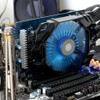A new Island and Technology
Them Islands Again
So, over the past two years you have been hearing about several codenames and that can be a little confusing. It's simple really, in the market we have entry level, mainstream and high-end products. When you notice "Cape Verde" that's entry level, such as the current 7700 series. Pitcairn would be the codename the mainstream products like the 7800 hide under, and Tahiti is the codename for the GPUs used on AMD's most high-end graphics cards.
- Entry level = Cape Verde = Radeon HD 7700 series / R5 series
- Mainstream level = Pitcairn / Bonaire = Radeon HD 7800 series / R7 series
- High-end level = Tahiti = Radeon HD 7900 series / R9 series
- Enthusiast level Hawaii = R9-290 and 290X / 295x2
The entire segment from top to bottom was released in Q1 2012, but most of the 2013 models are respins, the exception being the R7 260 and 260X and the R9-290/290X graphics cards.
R7 240
- Stream Processors 320
- Clock Frequency up-to 780 GHz
- 499 GFLOPS compute performance
- 1 or 2 GB memory at 4.6 Gbps / 128-bit
- 30W TDP
- PCI-E 3.0
- API - DirectX 11.2 / OpenGL 4.3 / Mantle
R7 250
- Stream Processors 384
- Clock Frequency up-to 1.05 GHz
- 806 GFLOPS compute performance
- 1 or 2 GB memory at 4.6 Gbps
- 65W TDP
- PCI-E 3.0
- API - DirectX 11.2 / OpenGL 4.3 / Mantle
R7 260
- Stream Processors 768
- Clock Frequency up-to 1.0 GHz
- 1.54 TFLOPS compute performance
- 1 GB memory at 6.0 Gbps / 128-bit
- 95W TDP
- PCI-E 3.0
- API - DirectX 11.2 / OpenGl 4.3 / Mantle
R7 260X
- Stream Processors 896
- Clock Frequency up-to 1.1 GHz
- 1.97 TFLOPS compute performance
- 2 GB memory at 6.5 Gbps / 128-bit
- 115W TDP
- PCI-E 3.0
- API - DirectX 11.2 / OpenGl 4.3 / Mantle
R9 270X (previously the R7870 GHz / Pitcairn)
- Stream Processors 1280
- Clock Frequency up-to 1.05 GHz
- 2.69 TFLOPS compute performance
- 2 or 4 GB memory at 5.6 Gbps
- 180W TDP
- PCI-E 3.0
- API - DirectX 11.2 / OpenGL 4.3 / Mantle
R9 280X (previously the R7970 GHz / Tahiti)
- Stream Processors 2048
- Clock Frequency up-to 1 GHz
- 4.1 TFLOPS compute performance
- 3 GB memory at 5.6 Gbps / 384-bit
- 250W TDP
- PCI-E 3.0
- API - DirectX 11.2 / OpenGL 4.3 / Mantle
The R7 260X is a new GPU, but the R9 270X and R9-280X are both derivatives of the Pitcairn and Tahiti GPUs respectively. Does anyone remember Oland, that mobile GPU? Well peek at the R7 250 specs, they look familiar right? There are a number of changes though to be found in clock and memory frequencies so overall there will be slight performance increments. AMD has now also fully implemented a 'Turbo' feature much like NVIDIA's boost technology on all of their products.
This means that there is no longer a fixed clock on these cards. The GPU clock will get a baseline and maximum frequency, in-between these two values the card will clock up/down based on power draw/limiters, performance and heat. In return the card will adaptively manage fan control, clock frequency and voltages (dynamic). AMS always has been much more reserved with the difference in between baseline and maximum frequency, so the difference in values won't be extremely big.
28nm Technology
The GPU architecture has remained the same. Comparable to the last-generation products, AMD still uses the 28nm process technology, the cards are PCIe gen 3 compatible and there have been significant changes on power consumption. We'll address all the features separately of course. With the launch of the R7 and R9 series you will also see Eyefinity updated towards version 2.0 DDM; audio is now fully supported (you hear audio on the actual monitor it's played off), the 5x1 landscape mode is introduced, and you may now create custom multi-monitor resolutions.
Interesting is that AMD now implemented next generation digital multipoint audio with smart channel splitting. So if you set up Eyefinity with three screens the six speakers in your monitors will now be configured as front left/mid/right channels. Very clever.
Eyefinity has also received a small update. You can now mix and match any monitor (similar monitors) output and create an Eyefinity setup. So if you have three of the same monitors you could hook up one to HDMI, one to DVI and one to DP. That is the kind of flexibility we like a lot alright.





